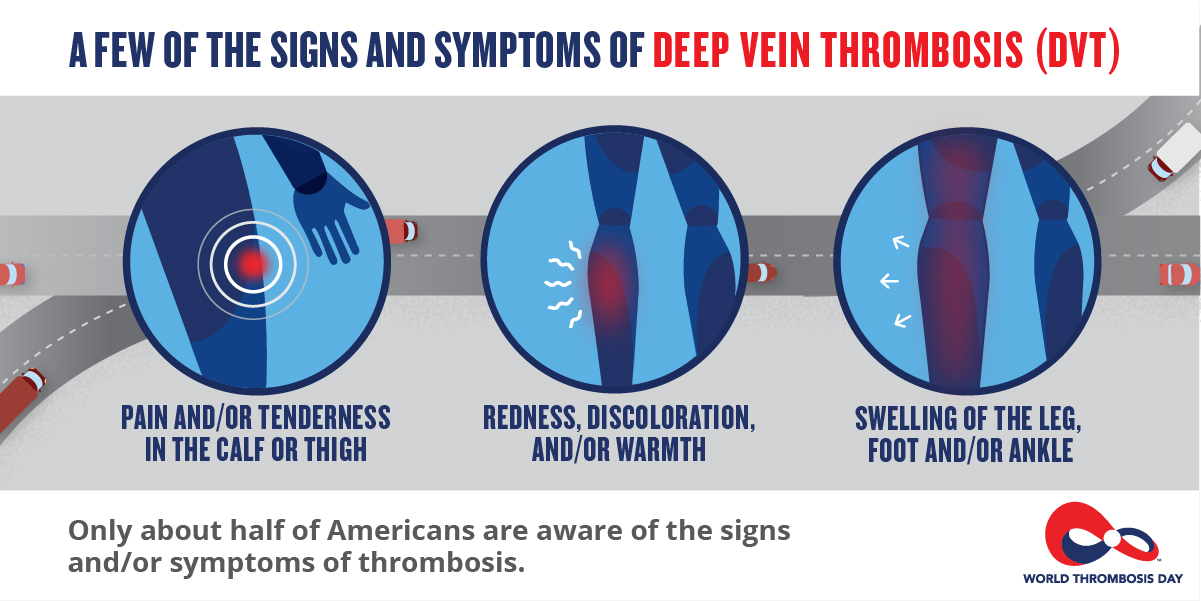Know Thrombosis: Think Deep Vein Thrombosis
Deep vein thrombosis or DVT, is a blood clot that forms in a vein deep in the body. Blood clots occur when something slows or changes the blood flow. Blood thickens and clumps together.
Most deep vein blood clots occur in the lower leg or thigh, however, they can also occur in other parts of the body such as the groin and arms.
A blood clot in a deep vein can break off and travel through the bloodstream. The loose clot is called an embolus. It can travel to an artery in the lungs and block blood flow. This condition is called pulmonary embolism, or PE, a very serious condition. Remember, DVT + PE = VTE.
A recent World Thrombosis Day Ipsos survey showed little awareness of DVT in countries around the world. We need your help to educate family, friends and colleagues year-round.
Signs and Symptoms

Be proactive. If you have a concern, contact your health care professional immediately.
Risk Factors
Many factors can increase your risk of developing deep vein thrombosis (DVT). The more you have, the greater your risk of DVT. Risk factors include:
- Inheriting a blood-clotting disorder. Some people inherit a disorder that makes their blood clot more easily. This condition on its own might not cause blood clots unless combined with one or more other risk factors.
- Prolonged bed rest, such as during a long hospital stay, or paralysis. When your legs remain still for long periods, your calf muscles don't contract to help blood circulate, which can increase the risk of blood clots.
- Injury or surgery. Injury to your veins or surgery can increase the risk of blood clots.
- Pregnancy. Pregnancy increases the pressure in the veins in your pelvis and legs. Women with an inherited clotting disorder are especially at risk. The risk of blood clots from pregnancy can continue for up to six weeks after you have your baby.
- Birth control pills (oral contraceptives) or hormone replacement therapy. Both can increase your blood's ability to clot.
- Being overweight or obese. Being overweight increases the pressure in the veins in your pelvis and legs.
- Smoking. Smoking affects blood clotting and circulation, which can increase your risk of DVT.
- Cancer. Some forms of cancer increase substances in your blood that cause your blood to clot. Some forms of cancer treatment also increase the risk of blood clots.
- Heart failure. This increases your risk of DVT and pulmonary embolism. Because people with heart failure have limited heart and lung function, the symptoms caused by even a small pulmonary embolism are more noticeable.
- Inflammatory bowel disease. Bowel diseases, such as Crohn's disease or ulcerative colitis, increase the risk of DVT.
- A personal or family history of deep vein thrombosis or pulmonary embolism. If you or someone in your family has had one or both of these, you might be at greater risk of developing a DVT.
- Age. Being older than 60 increases your risk of DVT, though it can occur at any age.
- Sitting for long periods of time, such as when driving or flying. When your legs remain still for hours, your calf muscles don't contract, which normally helps blood circulate. Blood clots can form in the calves of your legs if your calf muscles don't move for long periods.
Complications
A serious complication associated with deep vein thrombosis is pulmonary embolism or PE. Learn more about PE here.
